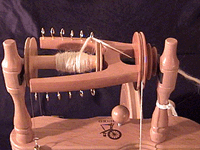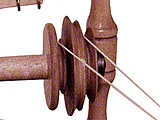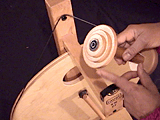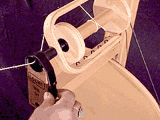WHO WE ARE
About Us
How I Started Handspinning
DROP SPINDLES
*Types of Drop Spindles
How To Make A Drop Spindle
Making Yarn With A Drop Spindle 
SPINNING WHEELS
Styles of Spinning Wheels
Parts Of The Spinning Wheel
*How The Spinning Wheel Works
* Adjusting The Wheel's Tension
*Drive Ratios & Twist
HANDSPINNING TECHNIQUES
Preparing To Spin 
Basic Handspinning Techniques 
Adding On More Fiber 
Spinning Woollen and Worsted Yarn
*Making A Skein With A Niddy Noddy
* "Setting In The Twist" Of Handspun Yarn
*Navajo Plying 
FIBER INFORMATION
Alpaca 
Angora 
Llama 
Mohair 
Silk
Wool 
WOOL PREPARATION
How to Wash Your Fleece
How to Use Hand Carders 
How to Use a Drum Carder
How to Use Dutch Combs
How to Use Mini-Combs
Using a Diz
DYEING INFORMATION
Natural Dyes
Natural Plant Dyeing
Mordants
Natural Dyeing: Helpful Tips
Dyeing with Gaywool Dyes
BUY EQUIPMENT & SUPPLIES
ONLINE PRODUCT CATALOG
Return Policy
Payment Options
Mail-in Order Form
*THE BOOK STORE
WOOLY WABBIT(TM) FARM
Meet the "Wooly Wabbits" 
Angora Rabbit Breeds
How to Care For Your Angora Rabbit
FEEDBACK
REQUEST INFORMATION
RELATED LINKS
*
WORLDWIDE LIST OF
SPINNING GUILDS
|
How The Spinning Wheel Works
 |
| The spindle and the drive wheel are rotated by a drive band.
The spindle whorl is either on the flyer or attached to the spindle. It has 2-3 different pulley sizes
which controls the speed of the flyer. The flyer has a row of hooks on one or both sides of the
U-shaped arms to guide the yarn onto the bobbin evenly. On double drive wheels, the bobbin is
rotated by its own pulley. On single drive wheels the bobbin has a separate brake to control its speed.
The fiber is twisted as the flyer rotates and the spinner holds the yarn. One revolution of the
flyer puts one twist into the yarn. The longer the yarn is held before letting it wind onto the
bobbin, the more twist it will receive.
|
| |
 Single Drive Wheels
Single Drive Wheels
This type of wheel has one drive band around the flyer wheel and the
flyer whorl. There is usually a separate brake on the bobbin using an adjustable brake band
or a tension wire (The Scotch Tension brake system), for the purpose of regulating the speed by which the yarn
winds onto the bobbin.When spinning, a brake is used to hold the bobbin still while the flyer continues to rotate. Increased tension
on the brake will cause the yarn to pull from your hands and to wind quickly onto the bobbin.
Single drive wheels are the best choice for beginning handspinners. The Scotch Tension brake system
is easier for beginners to operate and understand. The tension on the flyer and bobbin can be set at separate speeds,
which provides numerous adjustment levels for the beginner. You will be able to spin a variety of yarn types; soft,
lumpy, novelty, etc.
|
| |
 Double Drive Wheels
Double Drive Wheels
This type of wheel has the flyer whorl and bobbin next to one another
on the same side of the spindle. The drive band is doubled and forms a figure eight that loops onto
both the bobbin and the flyer whorl. The spinner decides where the drive band is placed on
the whorl depending upon the type of yarn to be spun. When spinning, both the flyer and the bobbin are
rotated by the drive band. The bobbin whorl is smaller in diameter than the flyer whorl, therefore, it will spin
faster than the flyer if there is no brake being used. Because of the high degree of twisting efficiency,
beginners who have a problem with overtwisting the yarn, will find the double drive wheel difficult to use at first.
|

 Bobbin Lead Wheels
Bobbin Lead Wheels
The Louet spinning wheel is a good example of a bobbin lead wheel.
The whorls are located on the bobbin instead of the flyer. The drive band goes around the drive wheel
and one of the bobbin whorls. There is a single leather brake band that lays across the end of the flyer.
It has an adjustable sleeve that can be tighten or loosened, to control the speed of the flyer. Bobbin lead
wheels are a good choice for a beginner spinner. The tension is easier to control, and there is more
traction created by the force of the drive wheel, which allows heavier, bulky yarns to wind onto the bobbin.
|
|

